15 Sales Skills That Separate The Best Reps From The Rest
So you want to learn what skills the best-of-the-best sales pros use to close more deals, crush their goals, and make boatloads of cash?
Of course, you do. You are reading this blog post!
To emulate what the top sales professionals do, you can:
- Shadow them for a few weeks (months?) and hope “sales skills osmosis” works.
- Try and find the time on their calendar to listen in on calls and cross your fingers that you sat in on the “right” calls.
- Let Gong’s AI do the work and rely on data, not guesses and assumptions.
#3 seems like the smart choice, right?
Speaking of Gong Data
If you are new to Gong/Gong labs, here is how we operate.
Gong captures anonymized data from our customers – web conference meetings, call recordings, and emails – and uses AI to analyze how seller and buyer behavior impacts success rates.
Millions of calls. Millions of emails. Millions of sales opportunities.
In practice, it looks something like this:

For this particular article, we reviewed millions upon millions of web conference meetings, phone calls, and emails to understand what separates the average sales rep from the pros.
These are the top sales skills… with data to support them.
#1 Sales Skills for Prospecting: The ideal talk-to-listen ratio
Cold calling is not for the faint of heart. It’s tough. It’s tricky. It can be grueling.
But the top sales reps are great at prospecting.
This is because they are rule-breakers.
For most sales calls, it’s about listening (we’ll get to that skill a bit later). As Aaron Burr once advised Hamilton (in Hamilton), “Talk less. Smile more.”
Sound advice… but NOT for prospecting calls.
The talk-to-listen ratio for successful prospecting calls is higher than unsuccessful ones.
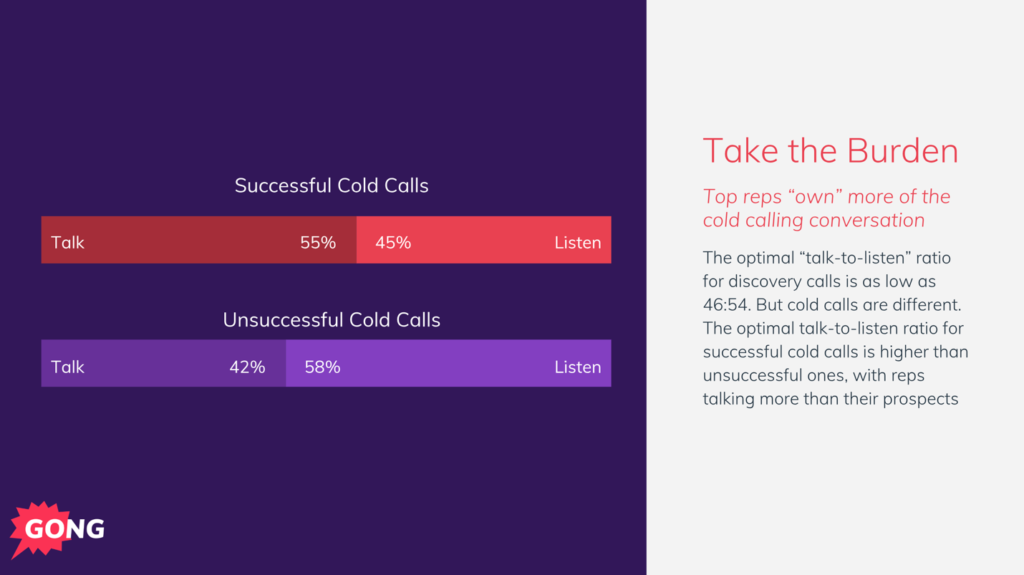
Specifically, successful cold/prospecting calls are ones where the rep talk-to-listen ratio is 55/45.
While that may sound crazy, the data prove it to be true.
Here’s why: Cold calling isn’t about discovery. It’s not trying to learn more about your future buyer. It’s not getting them to share their “top strategic priorities.”
The goal of prospecting is to sell the meeting.
In this prospecting call, that’s your only objective: Land the meeting and move the buyer down the funnel.
You can take care of top priorities, understand their pain, and how your solution can solve it AFTER you book the meeting.
Skip the discovery questions on the cold call. Instead, focus on selling the meeting.
#2 Sales Skills for Cold Calling: Ask, “How have you been?”
Speaking of cold calling…
Check this out: Including the cold call question “How have you been?” in a cold call improves your success rate by 6.6x compared to not using it:
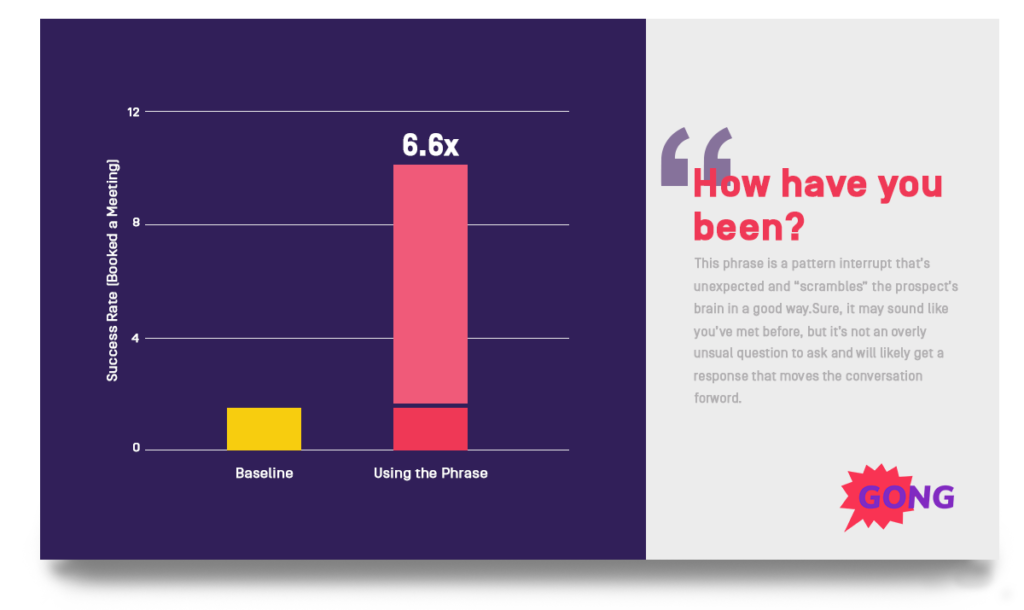
Cold calls that included “How have you been?” had a 10%+ success rate.
And here’s the funny thing. You’d think asking someone how they have been implies you’ve had a conversation with them before.
WRONG.
Remember: This is a cold call!
So why does this question perform so well?
Simple: It’s unexpected. It’s a “pattern interrupt” — a question that scrambles your prospect’s brain (a good scramble). It catches them off-guard.
And the data prove it to be effective.
Test it out on your next cold outreach.
#3 Sales Skills for Emailing Prospects: Longer emails perform better
“Nobody reads emails anymore.”
Not true. Allow me to modify — add a few words — to make that statement accurate.
“Nobody reads really crappy emails anymore.”
Another truth: Longer emails are significantly more effective in booking a meeting:
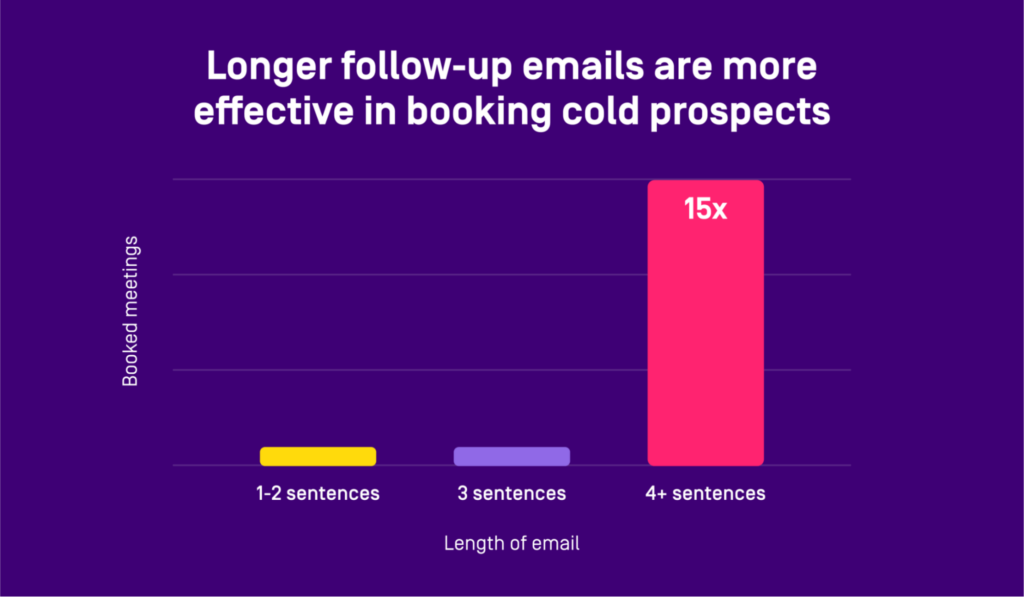
More specifically, prospecting follow-up emails 4+ sentences long are 15x more effective in booking cold prospects than shorter emails.
This sounds crazy, right? I was always taught “shorter is better” when it comes to email outreach. See the “nobody reads emails” comment above.
But short and concise are not necessarily the same. For example, you can have a short email (30 words or fewer) that says very little.
On the flip side, you can have a longer email, say 150 words, that’s tight/compact/concise.
Longer emails — those in the 30 to 150-word range — tend to perform better IF they are value-focused.
When it comes to prospecting follow-up emails, it’s perfectly fine (actually, preferred) to send a longer — personalized, direct, and intentional — email.
#4 Sales Skills for Pitching: The 9-minute rule
You’ve talked more than you listened. You asked, “How have you been?” You’ve sent a (long) follow-up email.
You landed the meeting.
Winning.
Now you enter pitch mode.
You are ready to share your sales deck. It’s a monster. You’ve trimmed it down and have “perfected” your 30-minute pitch.
The problem: You are 3x+ longer than your sales pitch should be.
Great salespeople never pitch for more than 9 minutes.
We recorded the audio and video of over 100,000 web-based sales meetings and analyzed them with Gong’s AI to glean this insight.
Here is what the data told us:
Deals that close use 9.1-minute sales deck presentations, on average, during the introductory sales meeting. Losing deals had 11.4-minute long sales decks, on average.
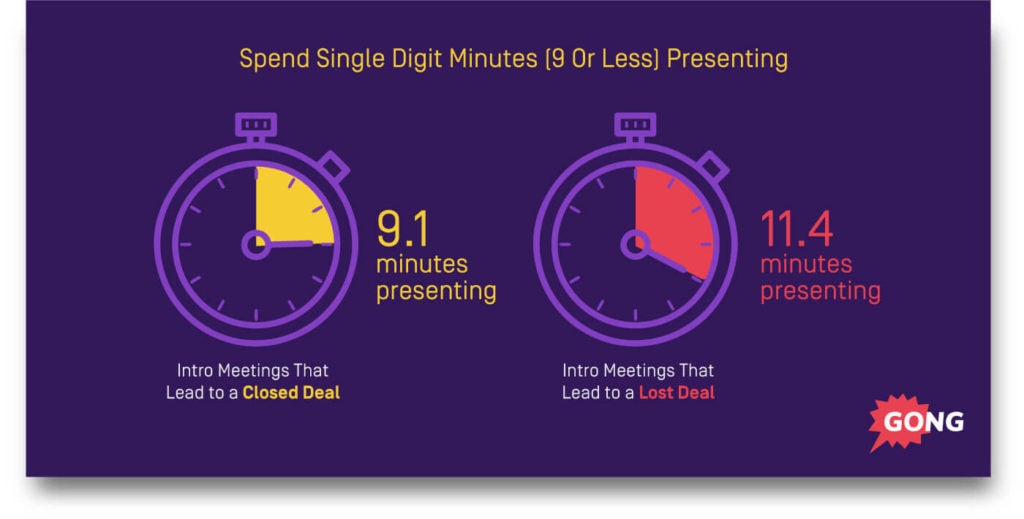
After 9 minutes, you risk your customer suffering from boredom — never a good thing.
Data from neuroscientists show our brains have a “built-in” stopwatch that turns off after 9-10 minutes.
You need to channel your inner Steve Jobs and introduce elements into your pitch that change the pace, alter the direction. A compelling story or video clip. A new speaker. A demo. Something that “wakes up” the brain.
We go into a bit more detail about the 9-minute rule in this blog post.
#5 Sales Skills for Asking Questions: Longer responses = more success
“Ask more questions” is good advice for any sales professional.
Yet, we all know quantity is not the silver bullet when questioning a prospective buyer. Quality — asking the “right” questions — is essential. That is if you want to be a sales superstar.
The key: Reframing your sales questions to elicit the responses you want.
To do this, you need to ask questions that elicit longer responses. Sure, you want your buyer to say “YES,” but even better if they say “YES, AND.”
There’s a clear correlation between longer responses and success rates.
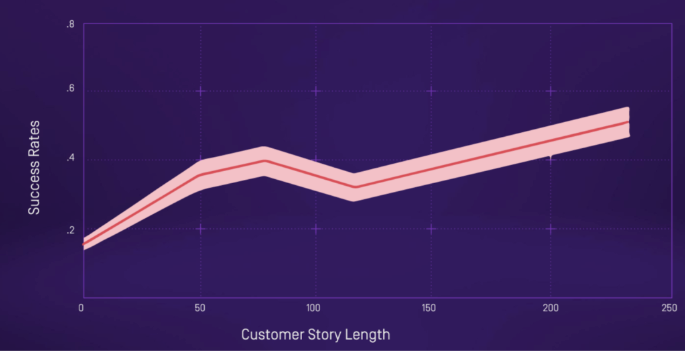
The longer answer you can pull from your buyer, the more data points you have for even more follow-up questions.
Even better: The more you know about your buyer’s situation — their pain — the more likely they will see your solution as the answer.
The next time you are on a sales call, try out a few of these sales questions to garner a longer reply:
- Context: What’s changed since the last time we spoke?
- Pain: Last time we met, we talked about solving [business challenge 1 and 2]. What’s missing from our list that’s worth covering today?
- Impact: How is this presenting itself as a problem to the business?
- Current state: How are you currently addressing [pain/problem]?
- Quantify impact: What would happen if we solved [business challenge]?
- Qualification: When evaluating a technology partner, what’s most important to you?
- Timing: What happens if we don’t address this [pain/challenge] now?
- Influencers: Who would feel left out if they didn’t attend the demo?
- Potential blockers: Who else will these changes affect?
- Buying process: Walk me through how you purchased [incumbent].
Notice with all of the above questions, there is no way for someone to answer with a simple yes/no.
#6 Sales Skills for Discovery: The magic number of questions to ask
11 to 14.
That’s the magic number, the sweet spot, if you will, for optimal discovery questions to ask.

However, as we highlighted in the previous section, not all questions are created equal.
Be sure your 11-14 questions are targeted, direct, and elicit long replies!
The last thing you want is to pepper your prospect with question after question (after question).
It’s a discovery call. Not an interrogation.
On the flip side, too few questions will not help to uncover your buyers’ pain points.
Note: The 11-14 recommendation does not hold when selling into the C-Suite. When selling to the C-Suite, win rates start to drop after 8 or so questions:
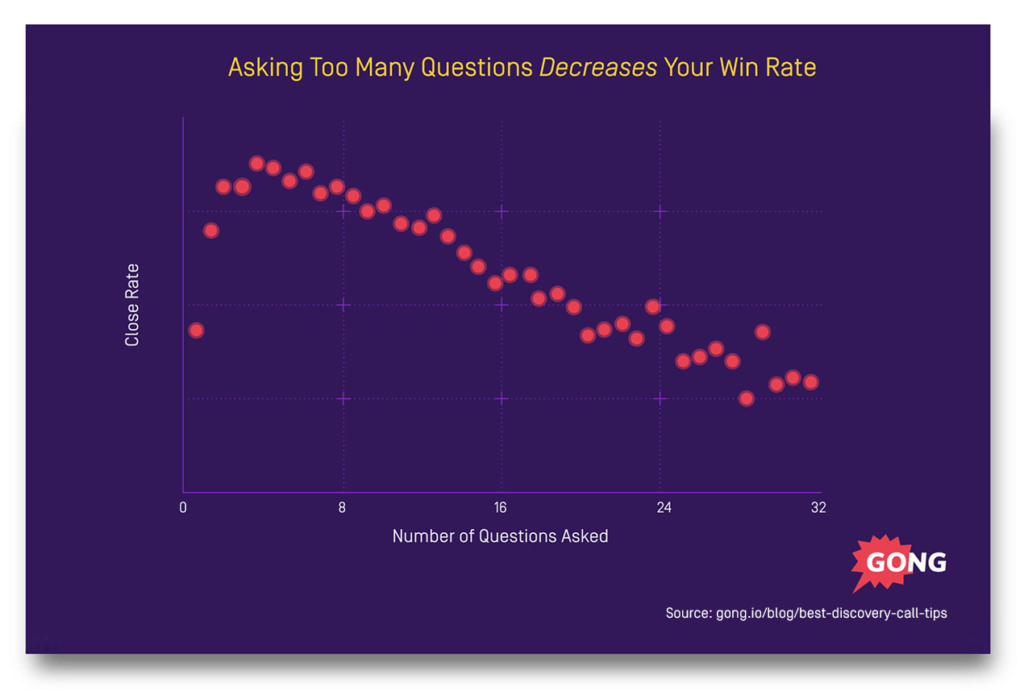
To get very specific, 4 questions are the optimal number of questions for executives:
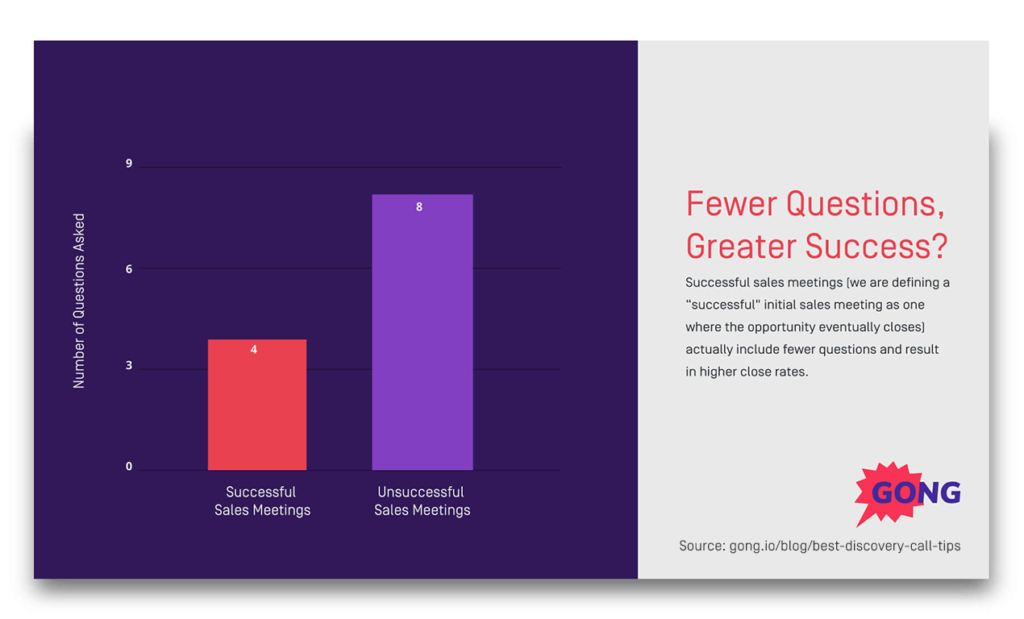
The reason (other than execs are super-busy) is you are likely not their first discovery call for this solution. They’ve been pulled into your competitor meetings. They are done answering the same questions.
To be clear, “just ask 4 questions” is not the silver bullet answer. If you are selling to the C-Suite, you are going to want to watch this webinar.
#7 Sales Skills for Listening: Listen more than you talk (post-cold calls)
Before you shout, “BUT WAIT, YOU TOLD ME TO TALK MORE!?” remember… the 55/45 talk-to-listen ratio was specific to prospecting calls — those calls where your goal is to sell the meeting.
More listening comes after that first call.
You’ve landed the meeting. You are in (or even beyond) discovery. You are in “learn and help” mode.
Listening is sometimes pegged as a “soft skill.” Call it whatever you want — it’s essential.
How much sellers listen has a strong correlation to their success.
Sales reps who live at 120%+ of quota have a talk-to-listen ratio of 46:54.
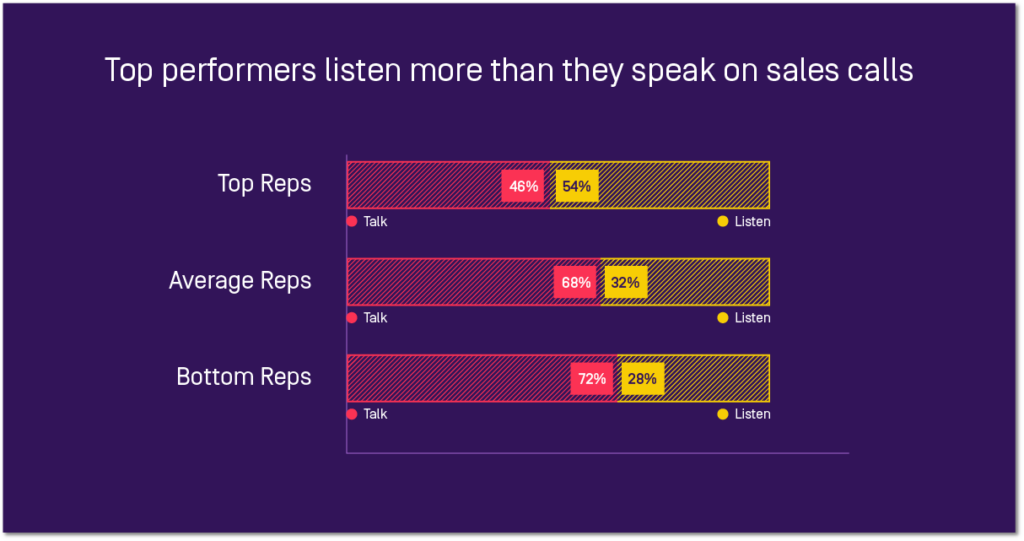
Said another way, top reps talk 46% of the time (and listen the other 54%).
Listen more = win more.
#8 Sales Skills for Driving Next Steps: You MUST discuss next steps (and value)
As any salesperson knows, one of the biggest mistakes you can make during the sales cycle is failing to discuss next steps.
The data prove it out: Close rates are higher when next steps are discussed… regardless of when in the sales cycle:
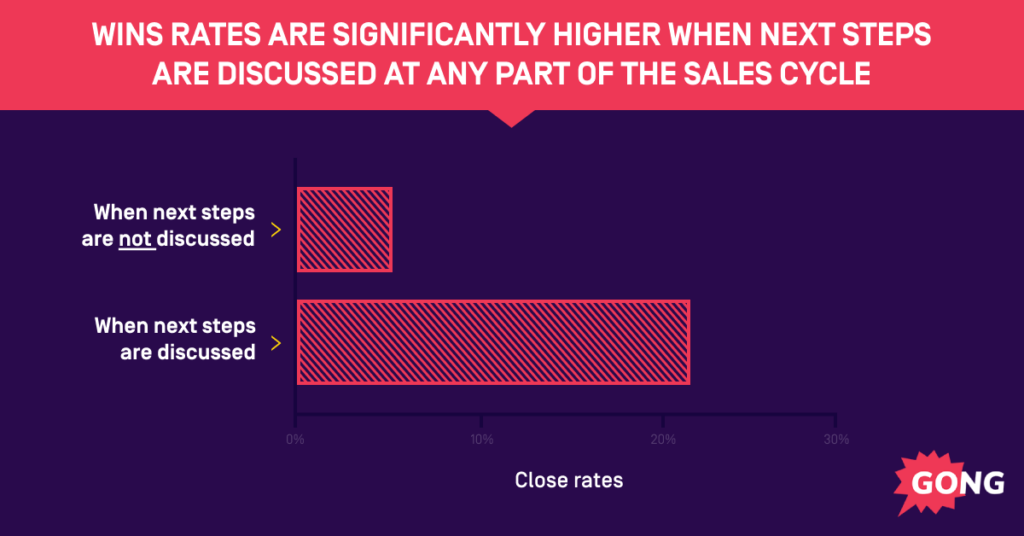
But “discussing next steps” is more than just locking in the next meeting. Having a date on the calendar — while important — is not sufficient to keep deals moving forward.
The key is talking about VALUE.
Value > Features
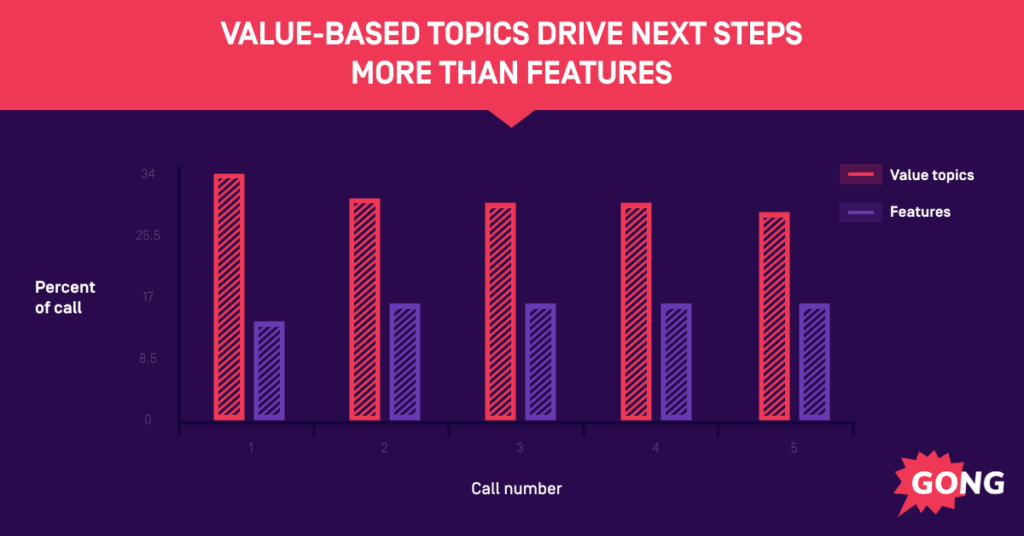
To review:
- Value conversations include discovery, business impact, and use cases
- Product conversations are, well, all about your product.
New sales reps fall into a “feature dump” far too often.
Yet, as you can imagine, the data prove when sellers focus on features, they are significantly less likely to earn a follow-up call.
Again, Value > Features. Value conversations help move the deal forward.
#9 Sales Skills for Presentations: Show them their pain
You are in sales to solve pain — to make your buyers’ lives easier and save them time or money (or both).
But here’s the thing: They may think they know their business pain, but your job is to expose that pain fully. If you are outstanding, you may be able to uncover pain they didn’t even know they had!
During your presentation, you have the unique opportunity to take down the most significant competitor you have – the status quo. “If you do nothing, this is what will inevitably happen.”
It’s imperative to expose the pain before revealing the gain (aka, how your solution relives that pain). By telling the status quo (where they live now, Point A) – you help your buyer understand they have a problem.

If you want to go next level (you do), put some numbers behind their pain. Data will help the prospect’s logical brain justify the decision. Here is a template to get you started:

As we discuss in this training video, “If your story describes their problem better than they can describe it themselves, they will automatically assume you have the best solution.”
Boom.
#10 Sales Skills for Objection Handling: Pause. Breathe. Speak with calm authority.
Objections are inevitable.
Rarely does a deal cross the finish line sans objections. Objections are a natural, very normal part of sales.
How you HANDLE said objections is the key.
Successful reps pause when they get objections. But not just any pause. Top reps pause 5x longer after an objection than during other parts of a sales call.
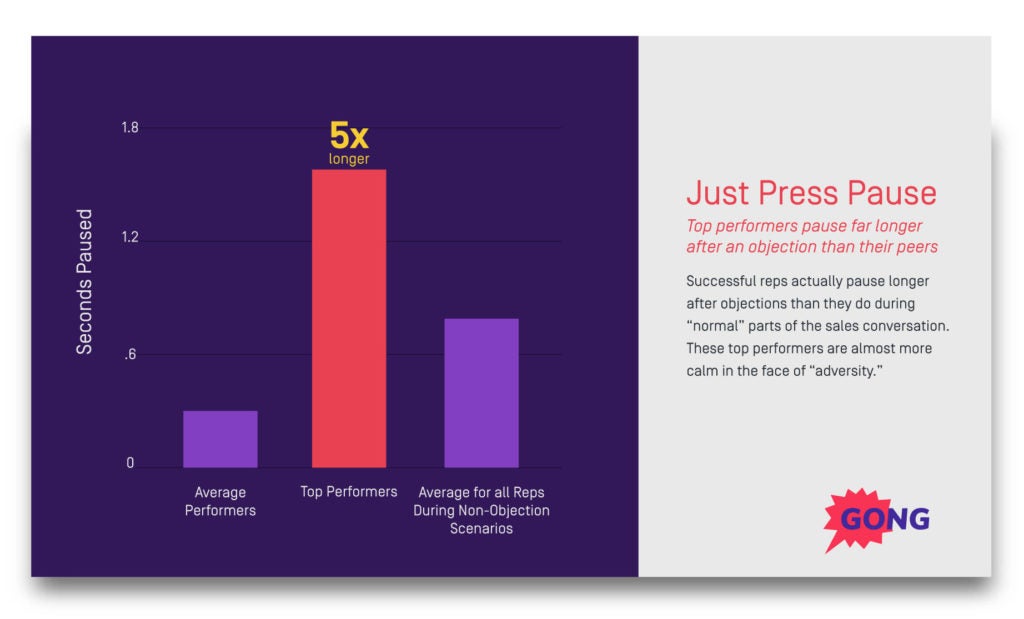
Unsuccessful reps tend to interrupt the customer when faced with an objection. As a result, they get flustered and nervous and often speak faster.
Case in point: During a normal sales conversation, the average talking speed is 173 words per minute (WPM). When faced with an objection, less successful reps start talking at 188 WPM. Top reps, on the other hand, only increase their WPM by 3.
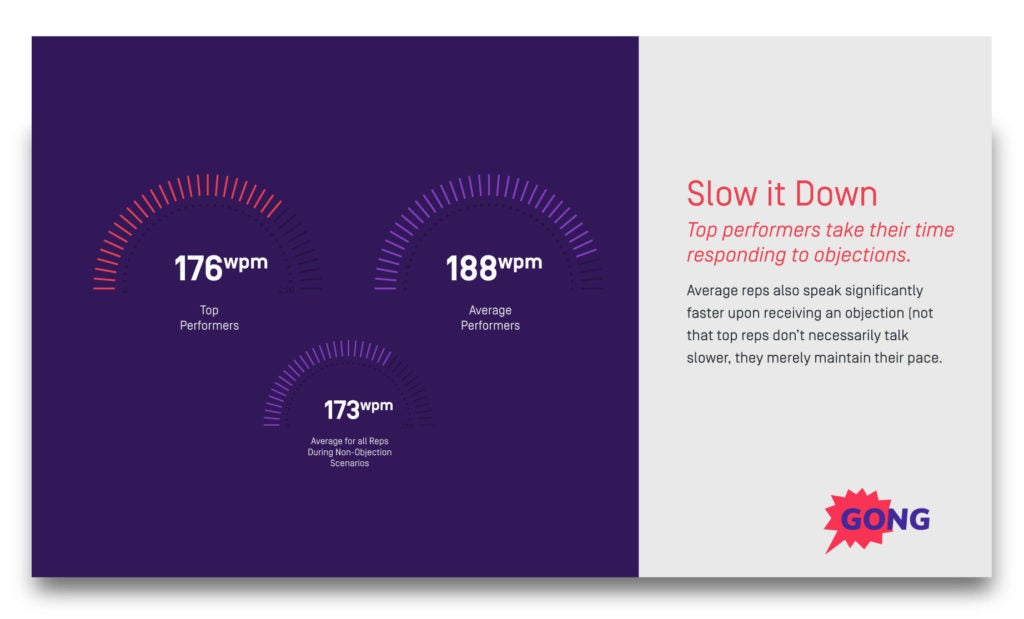
Remain calm and use these objection handling techniques. Build trust with your (soon-to-be) customer. Win more deals.
#11 Sales Skills for Rapport Building: Let them see you.
Speaking of building trust (and rapport), a faceless video call will not get the job done.
Appearances matter. Numerous studies have shown appearance has an enormous impact on how we perceive people — the clothes we wear, our facial expressions, and so on.
It’s hard to see all those assets when your video camera is in the “off” position!
Let customers see your face — smile, confidence, facial expressions. This immediately helps to build trust and rapport. Video shows authenticity, sincerity, and respect.
As humans, we lean on what we see (visual cues) to determine trustworthiness.
But remember: It’s not about being perfect. Err on the side of “being human.” Dog barking? Fine, as long as it’s not a huge distraction. Kid (or multiple kids) entering screen? All good. If you are working from home, you may have little humans do a drive-by. That is normal, especially post-March 2020.
And here’s the good news: Turning your webcam on during a sales call means you are 127% more likely to close a deal:
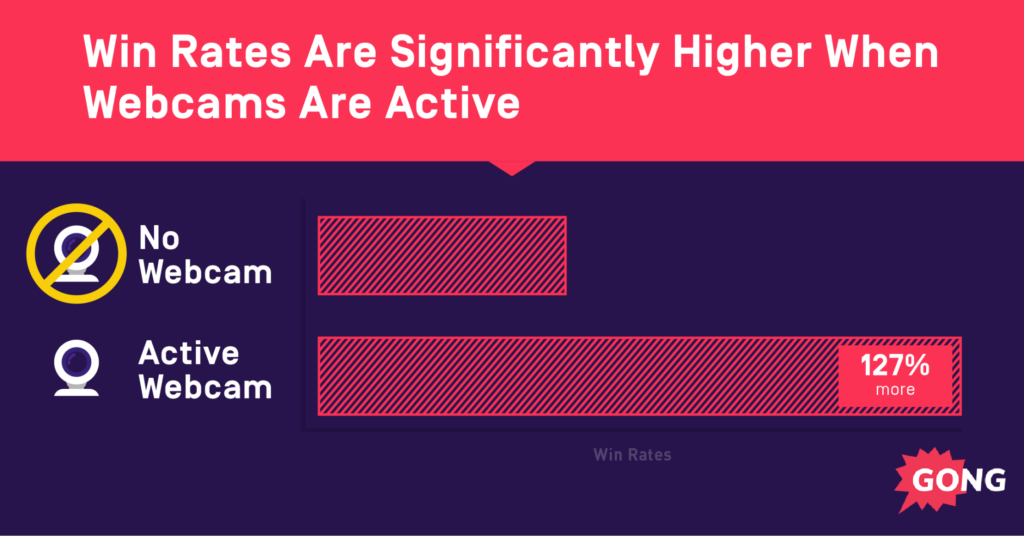
Video on = no-brainer.
Ready. Set. SMILE.
#12 Sales Skills for Multi-threading: Build your army of champions
We’ve been talking about multi-threading here at Gong for some time.
New here? Multi-threading is about building relationships with multiple stakeholders within your deal. It helps to build deal momentum. It’s huge.
Winning deals (on average) have at least 3 people from the buyer’s side in meetings across the sales cycle.
Losing deals: They usually can only get one point of contact to attend meetings. Usually, the first contact at an organization is their only contact.
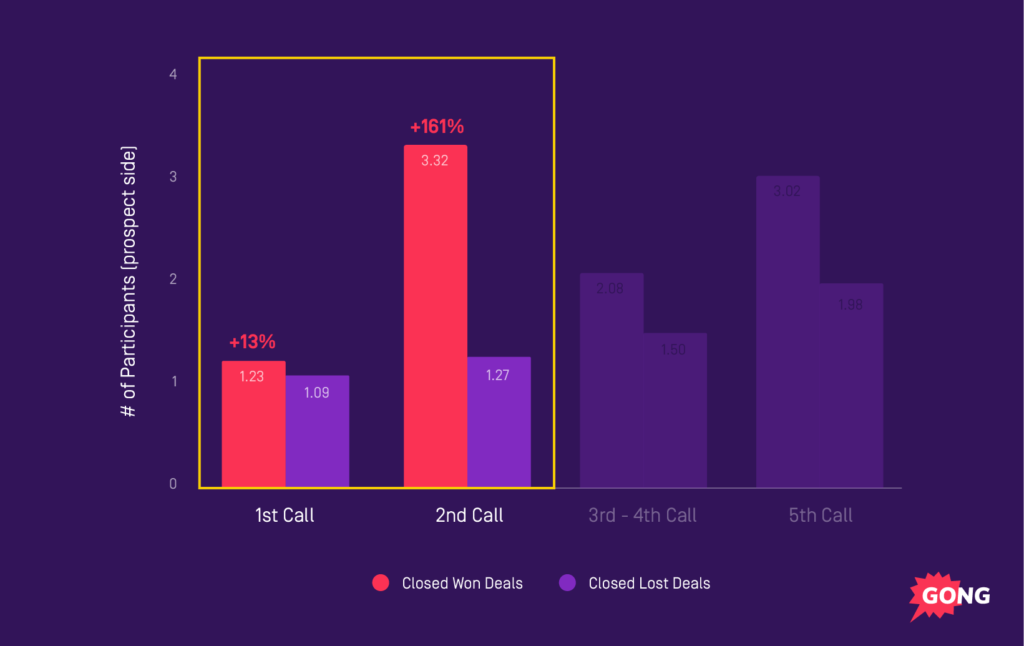
Another interesting point to note: Most deals start with just one point of contact on that first call. That makes sense.
But notice what happens on the second call: The number of buyer-side attendees nearly triples (for winning deals).
HUGE.
There are a few ways to help your odds of “building an army:”
- Build a compelling enough case that your buyer is excited and invites others to the next call.
- Learn about the organization to know who to invite. Which stakeholders are key?
Get your multi-threading game on.
#13 Sales Skills for Negotiation: Say “approved” instead of “list” when it comes to pricing
Words matter.
Use the “wrong” word, and your sales cycle can extend (generally, not a positive). Sales cycles extend by nearly 20% when a seller utters the phrase “list price” or “typical price” or “standard price”… at any point in the deal.
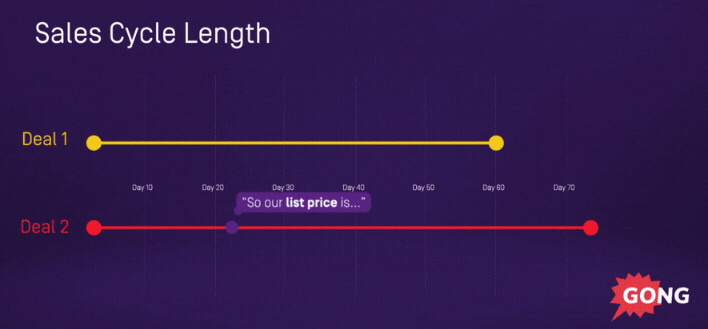
“List price,” in particular, is a phrase you want to avoid.
If you say “list price” during calls #1 or #2, you end up tripling the amount of time you spend discussing pricing later on. Not. Good.
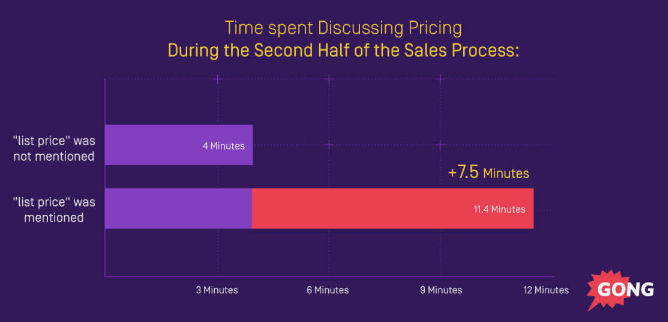
“Approved price” is the winning phrase.
That single word sway (approved for list) makes it seem less likely your price will change. “Approved” implies someone higher up the financial food chain (Sales VP, VP of Finance/CFO) has agreed to this price … and it’s set.
#14 Sales Skills for Closing: Negotiate over phone and email
Negotiating pricing is always tricky. As you’ll recall from above, always use “approved price” instead of “list price.”
But should you introduce price over email?
The data confirms this is a winning negotiation technique.
Discussing price over email has a significant, positive impact on win rates:

But the key is not just to limit price negotiations to email.
Meaning is often lost over email (or text or chat or other one-way communications). Also, email allows your buyer the luxury of time. There is no need to reply to an email immediately. They may choose to think it over, share your pricing with a competitor, or even counter.
So when you are negotiating pricing, add in the phone. Win rates are 3x higher when pricing is discussed via email and phone* (vs. just email or just phone).

*Web conferencing software, too.
#15 Sales Skills for Team Selling: The more, the better
As we detailed above, multi-threading is getting more buyer-side participants.
Team selling, on the other hand, is getting more seller-side participants in a deal.
The good news? Team selling, like multi-threading, dramatically increases win rates. The data prove it out.
Win rates double by adding a single co-worker from the seller’s side to the mix. Drop in 3+ and you see a >3x increase in win rate!
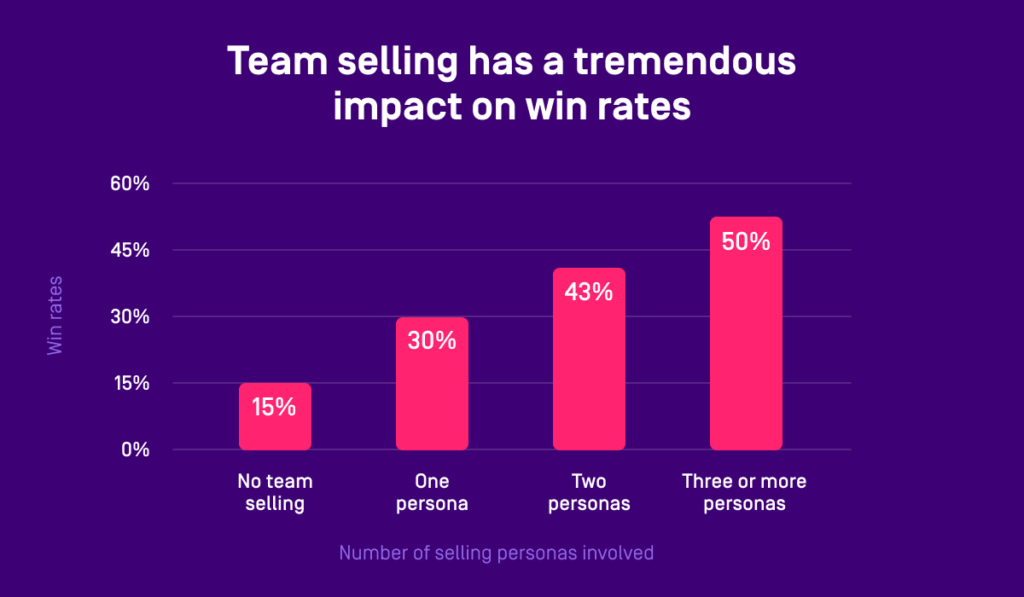
Team selling works for 3 reasons:
First, team selling helps to build trust. If you are willing to invest not only time, but resources in a deal, that’s a signal you care about the relationship and helping solve your buyer’s pain points.
Second, by adding experts via team selling, you build credibility: You are a sales rep. You SELL your offering. Engineers? They BUILT your product. They can answer those technical questions.
Third, investing valuable resources through team selling gives you a competitive edge: Time and expert resources means you can go deeper with customers. This separates you from the average seller.
No brainer.
Want to learn more about team selling? Download our Team Selling Cheat Sheet.
You are ready to become a deal closing machine.
You’ve done your homework. You’ve mastered the above sales skills. You’ve practiced. You are (almost) ready.
But one thing is missing: A master class for advanced, next-level sales skills.
The Advanced Sales Skills Master Class includes 3 modules:
- Closing Kit Master Class
- Multi-threading Master Class
- Negotiation Master Class